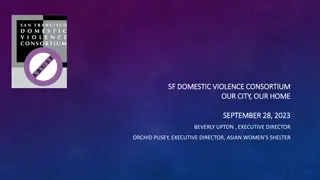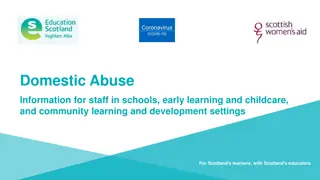Understanding Domestic Violence: The Different Forms of Abuse
Domestic violence, as defined by the NYS Office for the Prevention of Domestic Violence, involves a pattern of coercive tactics aimed at exerting power and control over an intimate partner. It extends beyond physical abuse to include emotional, psychological, sexual, financial, and non-physical forms of harm. This comprehensive understanding sheds light on the various types of abuse victims may endure, emphasizing the damaging impact of non-physical violence. Recognizing and addressing these different forms of abuse is crucial in combating domestic violence effectively.
Download Presentation

Please find below an Image/Link to download the presentation.
The content on the website is provided AS IS for your information and personal use only. It may not be sold, licensed, or shared on other websites without obtaining consent from the author. Download presentation by click this link. If you encounter any issues during the download, it is possible that the publisher has removed the file from their server.
E N D
Presentation Transcript
What is Domestic Violence? NYS Office for the Prevention of Domestic Violence defines DV as: A pattern of coercive tactics, which can include physical, psychological, sexual, economic and emotional abuse perpetrated by one person against an adult intimate partner with the goal of establishing and maintaining power and control over the victim.
What does that really mean? Focus is on pattern of coercive tactics and power and control. Differs from high conflict relationships Note the different types of IPV it s not just physical! In other words, abuse is any behavior that seeks to deprive the victim of independence and respect that the abuser demands for himself in the relationship.
Types of Abuse We often think of physical abuse when thinking of DV. Other types of abuse include: Sexual Non-physical Financial Emotional Psychological Victims have told us that these other forms of abuse can be much more damaging than physical violence.
Physical Abuse Strangling Strangling, punching, kicking, biting, shaking, hitting, whipping, shoving; Pushing, hair pulling, arm twisting, scratching Hitting head against wall, burning. Attacking with a weapon, or other item, such as a chair, table, cord, lamp, etc. Forcing alcohol or other drug use.
Harm without violence Physical harm can be caused without physical violence . . . Refusing to practice safe sex; knowingly transmitting STDs, HIV or other diseases; Forcing unsafe living conditions; Dangerous driving; Denying food, sleep, medication, health care, mobility aids; Revealing information to others.
Sexual Abuse Forcing unwanted or unprotected sex Objectification Not taking no for an answer Criticizing performance or desirability Jealousy, obsessiveness, accusations of infidelity Forcing sex with others Unwanted or unknown filming of a sexual act Revenge porn Sextortion
Internet Crime Online predators are increasing drastically with expansion of social networking sites and availability and access to technology. Children are particularly vulnerable to sexual predators, sexual offenses, and cyberbullying. Predators use social networking sites to gain insights into victim s habits and likes. Explicit sexual graphics, pornography and violence is easily accessible (YouTube, online gaming).
Financial Abuse Fostering financial dependency Controlling money & financial info Withholding money Hindering partner s work or school Making partner hand over paychecks Financial exploitation Making partner commit welfare fraud or other unlawful acts Getting into debt in partner s name Theft
Emotional/Verbal Abuse Emotional abuse is speech and/or behavior that s derogating, controlling, punishing, or manipulative. Erodes a person s self-esteem, self-worth, independence and makes them feel they are nothing without the abuser. Includes verbal abuse tactics: Opposing, Blocking, Discounting/Belittling; Undermining/Interrupting; Denying/Gaslighting
Examples of Emotional Abuse Opposing: The abuser will argue against anything you say, challenging your perceptions, opinions, and thoughts. Blocking: This is another tactic used to abort conversation. The abuser may switch topics, accuse you, or use words that in effect say, Shut Up. Discounting & Belittling: This is verbal abuse that minimizes or trivializes your feelings, thoughts, or experiences. It s a way of saying that your feelings don t matter or are wrong. Undermining & Interrupting: These words are meant to undermine your self-esteem and confidence, such as, You don t know what you re talking about.
Examples of Emotional Abuse (contd) Denying: An abuser may deny that agreements or promises were made or that a conversation or other events took place, including prior abuse. The abuser instead may express affection or make declarations of love and caring. This manipulative behavior leads the victim to gradually doubt her/his own memory, perceptions, and experience. You may have heard the term gaslighting to describe this type of extreme, persistent behavior. The term was derived from the Ingrid Bergman movie, Gaslight. In that movie, a husband used denial in a plot to make his wife believe she was losing her grip on reality.
Psychological Abuse Intimidation/infliction of mental anguish; scary behavior intended to frighten victim. Involves using tactics to make the victim appear or even feel unstable: Threatening to kill victim, children, and/or self Hurting animals or threatening to do so Threats, blackmail Stalking (can include seemingly innocuous gestures like sending notes and flowers), menacing, harassing Throwing things; destroying things partner values *Victims say that psychological and emotional abuse can be far more damaging than the physical assault.
Psychological Abuse (contd) Manipulation Lying, making & breaking promises Isolation from family & friends Restrictions Controlling partner s every move Exploiting vulnerabilities Homophobic control Control through disability
Tactics Used to Gain Power and Control Abuse is a choice. It s not about losing control -- it s about doing whatever it takes to gain and maintain power and control. Some tactics include: Isolation Intimidation Minimizing/denying/blaming Using children or pets Coercion and threats
Dynamics of DV Domestic violence is a complex dynamic that occurs on a continuum. The Cycle of Violence Theory was developed in 1979 by Dr. Lenore Walker and describes the phases an abusive relationship moves through in the lead up to a violent event and its follow-up. The cycle of violence looks at the repetitive nature of perpetrator s actions that hinder a victim s ability to leave an abusive relationship. The cycle of violence theory provides an insight into this by illustrating how the behavior of a perpetrator can change very dramatically, making it difficult for the woman to leave. Women who have experienced violence may recognize this cycle.
Why Do Victims Stay or Go Back to Abusive Partners?
Why Do Victims Stay or Go Back to Abusive Partners? Children Fear Culture/family influence/Religious beliefs Isolation Safety Self-blame, embarrassment, guilt Belief that abuser will change Economic dependency Unsure of where to go for help Love
Who is affected by DV? Statistics vary, but National Coalition Against Domestic Violence reports show 1 in 4 women and 1 in 9 men have experienced severe intimate partner physical violence, intimate partner contact sexual violence, and/or intimate partner stalking with impacts such as injury, fearfulness, post-traumatic stress disorder, and contraction of sexually transmitted diseases. 1 in 3 women and 1 in 4 men have experience some form of IPV. 44% of Lesbians and 61% of bisexual women have experienced rape, physical violence or stalking by an intimate partner. 26% of gay men and 37% of bisexual men have experienced rape, physical violence or stalking by an intimate partner. The 2015 U.S. Transgender Survey found 47% of transgender people are sexually assaulted at some time during their lifetime.
What does a DV victim look like? DV knows no boundaries. It does not discriminate! The majority of DV victims are women; however... DV affects every race and ethnicity, educational background, religious background, gender, sexual orientation, socio-economic level and occurs in every city, state and country around the world.
You never know what goes on behind closed doors
DV Fatalities in Westchester County In 2018, Richard DeLucia, 71, shot and killed his wife, Ann DeLucia, 70, with a licensed .38 caliber handgun before turning the gun on himself. Police later found a note in which the husband stated he was distraught over his wife s medical issues and wanted to end her suffering. Also in 2018, Cynthia Arce, 29, killed her two year old daughter Gabriella Boyd and then attempted to kill herself. Arce and Gabriella s father were in the middle of a custody dispute when Arce murdered their daughter. Arce also attacked and slashed two police officers who responded to a 911 call at the house. She pled guilty to 2nddegree Murder and Attempted Aggravated Assault and is scheduled to be sentenced on October 31, 2019 to 25 years to life. In 2017, Steven Dym, 56, shot and killed his wife Loretta Dym, 50, and their daughter Caroline with a shotgun before turning the gun on himself. Loretta Dym had returned from California the night before, after dropping their son off at college. Their house had recently been sold and indications of financial problems/fraud involving Steven Dym were uncovered after the murders.
DV Fatalities in Westchester (contd) In 2017, 7 year old Gabrielle White was suffocated to death by her father a day after he and Gabrielle s mother signed papers to finalize their divorce. Neil White, 47, was found with slash marks on his arms when police arrived at the scene. Neil White stated that he did not want his daughter to grow up with divorced parents. In 2016, Dr. Robin Goldman, 58, was stabbed by her husband, 61 year old Julius Reich, 21 times while showering; the couple was in the midst of a divorce at the time. In 2015, retired White Plains police officer Glen Hochman, 52, killed two of his daughters and his dogs before killing himself. His wife, who was out of town with their third daughter when the murders took place, reportedly had recently told the perpetrator that she wanted to end the marriage. In 2011, Amy Friedlander was bludgeoned to death by her husband. He then shot and killed both of their children with a 12-gauge shotgun before turning the gun on himself. They, too, were in the middle of a bitter divorce when the perpetrator killed the entire family.
What are we doing here in WC to address risk of lethality? In 2017, the Office for Women, along with 5 PDs in Northern Westchester, Hope s Door, PWJC, Probation and the DA s Office, was awarded a 2 year NYS grant to implement a pilot program to provide enhanced responses in domestic violence cases exhibiting high risk for lethality.
What are we doing here in WC to address risk of lethality? A victim s safety should not depend on where they live. We are rolling out a countywide Lethality Assessment program to provide enhanced responses to all high risk DV cases. Team consists of law enforcement, DA s Office, County agencies (Probation, OFW, DCMH, DSS), local NFPs, Westchester Medical Center.
Danger Assessment Tool The Danger Assessment Tool (DA) is an evidence-based model developed in 1985 by Dr. Jacquelyn Campbell, Associate Dean at Johns Hopkins University, to help victims and advocates better understand the threats to victims safety. It is a questionnaire designed to assess a woman's risk of being killed by an abusive partner. It is also designed to give women more of a role in planning their own safety, and to give them more personalized help. Many advocates are trained and certified in using this instrument and incorporate it as part of their safety planning. Police officers/first responders also trained in using DA tool as part of Lethality Assessment Program.
Danger/Lethality Assessment the 5 S s Separation- ALWAYS the most dangerous time Strangulation Stalking Suicide-includes threats and/or attempts to kill himself, you and/or children. *********************** SES: change in socio-economic status
Warning Signs of Abuse Does your intimate partner Isolate you from family and friends? Put you down? Try to control what you do/say/wear? Deny you access to money or financial assets? Blame YOU for everything that s wrong in the relationship? Accuse you over and over of being unfaithful? Force you into having sex when or in ways you don t want? Threaten to harm you, the children, your family, your pets or himself? Shove, hit, kick, bite, slap, punch, pull your hair?
What does DV look like to an Outsider? Signs/behaviors that MAY indicate that someone you know is experiencing DV, include: Visible physical injuries; Stress-related illnesses; Marital/family problems; Alcohol or other addictions; Depression, anxiety, suicidal thoughts or attempts; Leaving work early/arriving early; absenteeism/lateness; Strict adherence to start and end times for work or social events; Inability to go out with friends; Frequently cancelling plans; Constant checking in with partner; Having to get approval on every purchase; Abrupt changes in personality; Fatigue, sullenness.
Ways to Support Victims Ask: How can I help you? Support their right to make their own decisions. Understand that risks are attached to every decision they make! They know their abuser best. Reassure them that it s not their fault, that they are not alone, and that no one deserves to be treated this way. Express concern for their safety and that of their children. Connect them to local resources (counseling, legal, housing, immigration, safety planning).
What to Do and Not to Do DO offer support and concern. DO validate their experience; assure them they are not to blame and are not alone. DO refer them to a DV service provider for safety planning and other services. DON T suggest that they leave their partner! DON T suggest they immediately retain a lawyer. DON T give advice.
Key Take Aways ANYONE can be a victim of DV. Anyone can be an abuser. DV is not just physical; psychological/emotional abuse may be worse. Express concern for victim s safety and that of their children, and connect them to local resources do not give advice!
Resources Westchester County Office for Women: 995-5972 Refer to our website for a complete list of resources: women.westchestergov.com Westchester County Family Justice Center: 995-1880 Hope s Door: 747-0828 My Sister s Place: 683-1333 Pace Women s Justice Center: 287-0739 Legal Services of the Hudson Valley: 949-1305
Questions? Comments? Darlene Reda Office for Women (914) 995-3100























